- Joined
- Oct 9, 2007
- Messages
- 47,454 (7.50/day)
- Location
- Hyderabad, India
| System Name | RBMK-1000 |
|---|---|
| Processor | AMD Ryzen 7 5700G |
| Motherboard | ASUS ROG Strix B450-E Gaming |
| Cooling | DeepCool Gammax L240 V2 |
| Memory | 2x 8GB G.Skill Sniper X |
| Video Card(s) | Palit GeForce RTX 2080 SUPER GameRock |
| Storage | Western Digital Black NVMe 512GB |
| Display(s) | BenQ 1440p 60 Hz 27-inch |
| Case | Corsair Carbide 100R |
| Audio Device(s) | ASUS SupremeFX S1220A |
| Power Supply | Cooler Master MWE Gold 650W |
| Mouse | ASUS ROG Strix Impact |
| Keyboard | Gamdias Hermes E2 |
| Software | Windows 11 Pro |
Here are pictures of the release-grade revision (1.0) of Gigabyte's socket LGA2011 motherboards in its main linuep, the GA-X79-UD3 and GA-X79-UD5. These are the release-grade 1.0 revisions, that are redesigned for X79 chipset with just six SATA ports (doing away with SAS). With the LGA2011 motherboard lineup, Gigabyte is doing away with the "UD7" model, in its segment there is GA-X79-OC. We saw this coming, because UD7 was meant to be an overclocking motherboard identifier. On the company website, for example, the product page of GA-X58A-UD7 (2.0) shows GA-X58A-OC as a "newer model". The GA-X79-UD3 is poised to be the most affordable LGA2011 motherboard from Gigabyte, while the GA-X79-UD5 offers some premium connectivity and memory expansion features.
The GA-X79-UD3 uses a simple 8+1 phase VRM to power the LGA2011 CPU. The memory is powered by a 4-phase VRM. There are just four DDR3 DIMM slots, one per channel. There are four PCI-Express 3.0 x16 slots, among which two are x16 capable, and all four are x8 capable. There are two PCIe x1, and surprisingly, a legacy PCI slot (uncommon for LGA2011 platform). All six SATA ports from the X79 chipset are assigned as internal ports: two SATA 6 Gb/s (white), and four SATA 3 Gb/s (black). Three Marvell-made SATA 6 Gb/s controllers provide four additional internal ports (gray), and two eSATA 6 Gb/s. There are just four USB 3.0 ports, two on the rear panel, and two via internal header. 8+2 channel HD audio, a number of USB 2.0 ports, and one gigabit Ethernet connection make for the rest of the GA-X79-UD3.
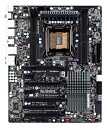
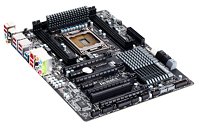
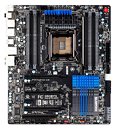
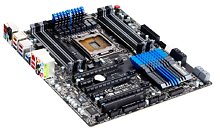
The GA-X79-UD5, on the other hand, uses a different PCB from that of the UD3, with more room for memory expansion thanks to eight DDR3 DIMM slots (two per channel). It uses a beefier CPU VRM, with 14-phases and POSCAP capacitors. Again, the memory is powered by a 4-phase VRM. Unlike the UD3, the GA-X79-UD5 compromises with expansion slots. The UD3 uses all seven expansion slot bays on an ATX case, but the UD5 uses just six. What's more surprising here is that the scapegoat isn't the legacy PCI slot, but a PCI-Express 3.0! This board, unlike the UD3, has just three PCI-Express 3.0 x16 slots, among which two are x16 capable, and all three are x8 capable. Storage connectivity is similar to the UD3, with two SATA 6 Gb/s (white), and four SATA 3 Gb/s (black) from the X79 PCH, four additional SATA 6 Gb/s ports (gray) and two eSATA 6 Gb/s ports from Marvell-made controllers. It has the same number of USB 3.0 ports as the UD3: 2 (rear) and 2 (header). Other connectivity is identical, except that this board also has Firewire.
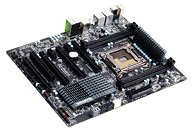
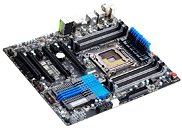
View at TechPowerUp Main Site
The GA-X79-UD3 uses a simple 8+1 phase VRM to power the LGA2011 CPU. The memory is powered by a 4-phase VRM. There are just four DDR3 DIMM slots, one per channel. There are four PCI-Express 3.0 x16 slots, among which two are x16 capable, and all four are x8 capable. There are two PCIe x1, and surprisingly, a legacy PCI slot (uncommon for LGA2011 platform). All six SATA ports from the X79 chipset are assigned as internal ports: two SATA 6 Gb/s (white), and four SATA 3 Gb/s (black). Three Marvell-made SATA 6 Gb/s controllers provide four additional internal ports (gray), and two eSATA 6 Gb/s. There are just four USB 3.0 ports, two on the rear panel, and two via internal header. 8+2 channel HD audio, a number of USB 2.0 ports, and one gigabit Ethernet connection make for the rest of the GA-X79-UD3.




The GA-X79-UD5, on the other hand, uses a different PCB from that of the UD3, with more room for memory expansion thanks to eight DDR3 DIMM slots (two per channel). It uses a beefier CPU VRM, with 14-phases and POSCAP capacitors. Again, the memory is powered by a 4-phase VRM. Unlike the UD3, the GA-X79-UD5 compromises with expansion slots. The UD3 uses all seven expansion slot bays on an ATX case, but the UD5 uses just six. What's more surprising here is that the scapegoat isn't the legacy PCI slot, but a PCI-Express 3.0! This board, unlike the UD3, has just three PCI-Express 3.0 x16 slots, among which two are x16 capable, and all three are x8 capable. Storage connectivity is similar to the UD3, with two SATA 6 Gb/s (white), and four SATA 3 Gb/s (black) from the X79 PCH, four additional SATA 6 Gb/s ports (gray) and two eSATA 6 Gb/s ports from Marvell-made controllers. It has the same number of USB 3.0 ports as the UD3: 2 (rear) and 2 (header). Other connectivity is identical, except that this board also has Firewire.


View at TechPowerUp Main Site







